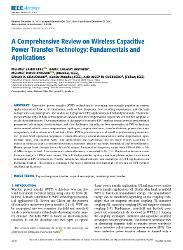| dc.contributor.author | Erel, Mehmet Zahid | |
| dc.contributor.author | Bayindir, Kamil Cagatay | |
| dc.contributor.author | Aydemir, Mehmet Timur | |
| dc.contributor.author | Chaudhary, Sanjay K. | |
| dc.contributor.author | Guerrero, Josep M. | |
| dc.date.accessioned | 2023-10-19T15:11:53Z | |
| dc.date.available | 2023-10-19T15:11:53Z | |
| dc.date.issued | 2022 | |
| dc.identifier.issn | 2169-3536 | |
| dc.identifier.uri | https://doi.org/10.1109/ACCESS.2021.3139761 | |
| dc.identifier.uri | https://hdl.handle.net/20.500.12469/5265 | |
| dc.description.abstract | Capacitive power transfer (CPT) technology is becoming increasingly popular in various application areas. Due to its limitations, such as low frequency, low coupling capacitance, and the high voltage stress on metal plates, the studies on high power CPT applications fell behind previously. Therefore, the wideband gap (WBG) semiconductor devices and the compensation topologies are further adopted to tackle these limitations. The main purpose of the paper is to review CPT applications in terms of performance parameters, advantages, disadvantages, and also challenges. Initially, the basic principles of CPT technology are examined, which cover compensation topologies, coupler structures, transfer distance, power electronic components, and system control methods. Then, CPT applications are evaluated for performance parameters (i.e., power level, operation frequency, system efficiency, transfer distance) along with compensation types, inverter types, and coupler types. The applications are categorized into six main groups according to industrial topics as safety, consumer electronics, transport, electric machines, biomedical, and miscellaneous. Herein, power level changes from mu W to kW ranges, the operation frequency varies from 100s of kHz to 10s of MHz ranges as well. The maximum system efficiency is recorded as 97.1 %. The transfer distance varies from mu m range to 100s of mm ranges. The full-bridge inverter topology and four-plate coupler structure are noticeable in CPT applications. Finally, advantages, disadvantages, and challenges of CPT applications are evaluated in detail. This review is expected to serve as a reference for researchers who study on CPT systems and their applications. | en_US |
| dc.language.iso | eng | en_US |
| dc.publisher | IEEE-Inst Electrical Electronics Engineers Inc | en_US |
| dc.relation.ispartof | Ieee Access | en_US |
| dc.rights | info:eu-repo/semantics/openAccess | en_US |
| dc.subject | Class-D Converter | En_Us |
| dc.subject | Transfer System | En_Us |
| dc.subject | Design | En_Us |
| dc.subject | Transmission | En_Us |
| dc.subject | Coupler | En_Us |
| dc.subject | Optimization | En_Us |
| dc.subject | Cmos | En_Us |
| dc.subject | Performance | En_Us |
| dc.subject | Rectifier | En_Us |
| dc.subject | Topology | En_Us |
| dc.subject | Capacitive power transfer | en_US |
| dc.subject | capacitive coupling | en_US |
| dc.subject | wireless power transfer | en_US |
| dc.title | A Comprehensive Review on Wireless Capacitive Power Transfer Technology: Fundamentals and Applications | en_US |
| dc.type | review | en_US |
| dc.identifier.startpage | 3116 | en_US |
| dc.identifier.endpage | 3143 | en_US |
| dc.authorid | Guerrero, Josep M./0000-0001-5236-4592 | |
| dc.authorid | Aydemir, Mehmet Timur/0000-0001-9405-6854 | |
| dc.authorid | Vasquez, Juan C./0000-0001-6332-385X | |
| dc.authorid | Chaudhary, Sanjay Kumar/0000-0001-8812-3571 | |
| dc.identifier.volume | 10 | en_US |
| dc.department | N/A | en_US |
| dc.identifier.wos | WOS:000741989700001 | en_US |
| dc.identifier.doi | 10.1109/ACCESS.2021.3139761 | en_US |
| dc.identifier.scopus | 2-s2.0-85122586338 | en_US |
| dc.institutionauthor | N/A | |
| dc.relation.publicationcategory | Diğer | en_US |
| dc.authorwosid | Guerrero, Josep M./D-5519-2014 | |
| dc.authorwosid | Aydemir, Mehmet Timur/ABH-1551-2020 | |
| dc.authorwosid | Vasquez, Juan C./J-2247-2014 | |
| dc.authorwosid | Chaudhary, Sanjay Kumar/I-1879-2018 | |
| dc.khas | 20231019-WoS | en_US |
















